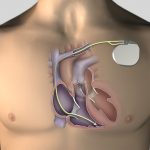What is a pacemaker?
A pacemaker is a device that treats a slow heart rhythm. The pacemaker is usually smaller than a normal matchbox and contains an electric circuit and battery. The pacemaker is usually inserted under the skin just below your collarbone and gives electric impulses through one or more leads that run down a vein to your heart.
What are the benefits of a pacemaker?
You may be at risk of developing an abnormal heart rhythm or you may have had an abnormal heart rhythm.
A pacemaker is designed to sense if your heartbeat is too slow, and to give short electric impulses or paced beats to stimulate your heart to beat (pacing).
Are there any alternatives to a pacemaker?
Sometimes changes to your medication can help with a slow heart rhythm.
Some symptoms of an abnormal heart rhythm can be treated using medication.
What will happen if I decide not to have a pacemaker?
Your doctor may be able to recommend an alternative treatment but you may be at a higher risk of having a cardiac arrest and dying suddenly.
What does the procedure involve?
Inserting a pacemaker usually takes 45 minutes to an hour.
Your heart specialist will inject local anaesthetic into the area just below your collarbone.
Your heart specialist will make a cut just below your collarbone and pass a lead down a vein to your heart.
When the lead reaches your heart, it is normal for your heart to beat a few extra times (palpitations). If you need more than one lead, your heart specialist will repeat this procedure. They will take x-rays to check that the leads are in the right position.
Your heart specialist will create a pocket under the skin just below your collarbone to insert the pacemaker in.

What complications can happen?
Some complications can be serious and can even cause death.
- pain or discomfort
- bruising where the pacemaker was inserted
- bleeding after the procedure
- pneumothorax, where air escapes into the space around your lung
- blood leaking into the sac that surrounds your heart
- developing a blood clot in a vein in your arm
- allergic reaction to the equipment, materials or medication
- infection of the surgical site
- the pacemaker developing a fault
- a lead moving out of place
- the pacemaker battery showing through your skin
- radiation exposure
- electro-magnetic fields interfering with the pacemaker
How soon will I recover?
You should be able to go home the same day or the day after.
It is important not to do strenuous exercise for 2 to 4 weeks, particularly exercise that involves you moving your shoulder.
The type of work you can do may also be affected, particularly if your job involves operating machinery.
Regular exercise should improve your long-term health. Before you start exercising, ask the healthcare team or your GP for advice.
You will be monitored through your smartphone or a special device called a home monitor box. You may have regular check-ups every 6 to 12 months. The battery be will be monitored remotely. You may need a new battery after 7 to 10 years. The battery is replaced and the leads are checked during a small procedure under a local anaesthetic.


